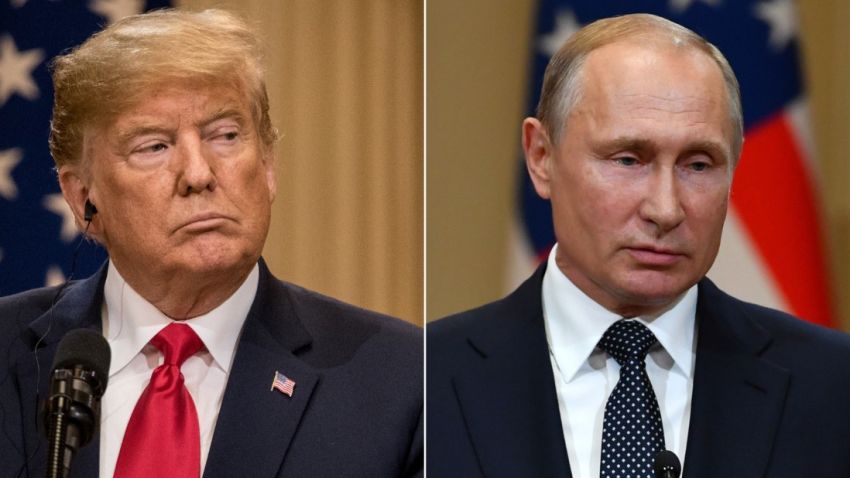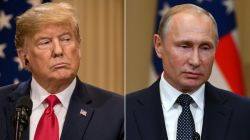Editor’s Note: David A. Andelman, executive director of The Red Lines Project at the Center for National Security at Fordham University, is a contributor to CNN where his columns won the Deadline Club Award for Best Opinion Writing. Author of “A Shattered Peace: Versailles 1919 and the Price We Pay Today,” he was formerly a foreign correspondent for The New York Times and CBS News. Follow him on Patreon and Twitter @DavidAndelman. The views expressed in this commentary are his own. View more opinion on CNN.
It’s hard to single out any one event as the most cataclysmic of Donald Trump’s presidency, in terms of American and global security. There was his bolting from the Iran nuclear deal (and Iran’s subsequent resumption of uranium enrichment). There was baiting Kim Jong Un, followed by engagement, which will likely result in a more advanced North Korean nuclear program. Then, of course, there’s the end to American participation in climate-change mitigation, not to mention a trade war with China.

But if I were to identify one event that could well have the most catastrophic results over the long term, it is Trump’s ill-considered decision to ditch the Intermediate Nuclear Forces Agreement with Russia. That action will come full on Friday, August 2, when the United States, having given its six-month notice, will be out of it entirely, and the treaty utterly void. The result? Likely another unparalleled arms race, a growth in global insecurity, and a tacit license for more countries to seek nukes of their own.
At the moment it was negotiated in 1986, as explained in the book by historian and journalist Guillaume Serina that I translated from the French, “An Impossible Dream: Reagan, Gorbachev and a World Without the Bomb,” the US was far better positioned for a major arms race than was the Soviet Union — a reality that both US President Ronald Reagan and Soviet leader Mikhail Gorbachev, but especially the latter, understood. That is certainly no longer the case.
Still, there are certain constants that are as true, and perilous, today as they were then. In the 1980s, nuclear-armed missiles of various ranges were proliferating with few checks on their numbers or lethality.
Intermediate range nuclear (INF) missiles were originally based in Europe, but with the proliferation of nuclear forces in Asia, were beginning to pose a series of global and regional challenges.
Intercontinental ballistic missiles (ICBMs) were largely the domain of the United States and the Soviet Union. These were at the heart of the Cold War nuclear standoff and the often-tense peace guaranteed by the doctrine of Mutually Assured Destruction (which held that if one side attacked, the other would respond, and both sides would be destroyed — a dynamic that deterred anyone from launching a first strike). And, of course, there was always the ultimate fear of a horrific error in judgment or technology.
So from the early 1970s into the 2000s, a succession of discussions was held between the two superpowers that led to treaties designed to put a cap on the numbers and lethality of these weapons that both sides recognized were the surest path to Armageddon. SALT I and SALT II (Strategic Arms Limitation Talks), signed in 1972 and 1979, placed caps on the numbers of intercontinental ballistic missiles.
That still left, largely unrestrained, all intermediate range (INF) missiles, based in Europe and the Soviet Union. This was the goal of the summit held in Reykjavik, Iceland, between Reagan and Gorbachev in 1986, when the Soviet leader sprang on an astonished US president a proposal to eliminate all nuclear weapons held by both sides. The catch? Reagan would have to end his “Star Wars” missile-defense system. He refused. The meeting ended with no agreement. Still, it was a landmark moment — the closest the world has ever approached to an end to all nuclear arms.
But neither side was prepared to give up. The discussions that began in Reykjavik led to other, more modest but enduring nuclear pacts, along two tracks that have stood the test of time. The most immediate result of Reykjavik was the Intermediate Range Nuclear Forces (INF) treaty, signed December 8, 1987, whose provisions eliminated all ground-launched ballistic and cruise missiles with ranges from 500 to 5,500 kilometers. But its precedent-shattering provision was an intrusive system of on-site inspections, laying the groundwork for verification of new ICBM treaties — the Strategic Arms Reduction Treaty, or START I, which arrived seven years later, and New C, which exists today. These slashed the number of deployed nuclear warheads from 6,000 under START I to 1,550 today.
While neither has managed to prevent the slow and equally destabilizing arrival of new nuclear powers (China, India, Pakistan, Israel, eventually North Korea, and possibly someday Iran), both sets of treaties — Start and INF — have very much stood the test of time. Until now.
Last fall, Trump, who arrived with his tortured sense of East-West rivalry and American supremacy, suddenly and arbitrarily announced his intention to pull out of the centerpiece of the nuclear-arms-control process launched in the 1980s: the INF Treaty. When Trump announced his decision to withdraw from the INF treaty after the six-month window that ends August 2, Russian President Vladimir Putin took the opportunity to bolt from the treaty, too. Each side charged the other with violations — and with some justification. The problem is that Trump may not have recognized that today’s Russia is quite different from Gorbachev’s.
In February, Putin outlined the shape of this new world in his annual state-of-the-nation address. Behind him flashed video and animations of next-generation ICBMs, nuclear-powered hypersonic cruise missiles, underwater drones and other devices Russia had developed and that it now felt free to deploy. “The capability of such weapons,” he warned, “will be equivalent to the threats against Russia.”
Indeed, with communism dead, the new proto-capitalist Russia, supported by high oil prices, is a more formidable enemy by far and, as Putin suggested, in a position to make good on threats once viewed as largely empty bluster from his Kremlin predecessors. The US is developing similar weapons, including hypersonic weapons able to travel nine times the speed of sound and largely impervious to any existing missile defense systems. American officials have conceded, however, that, while working diligently on such advances, the US is years away from testing and deployment, while Putin has at least claimed Russia will make its first deployments this year.
Despite all of Trump’s braggadocio of “rebuilding our military like we never have before,” the US seems suddenly to find itself in the deeply uncomfortable and unprecedented position of playing catchup in an arms race where Russia could begin calling the shots.
At the same time, it leaves America’s closest allies questioning the value of counting on a nuclear security umbrella controlled by the US, which has suddenly become an unpredictable and irrational partner, and whose leadership appears to be in disturbing agreement with their most pernicious enemy — Russia. It is little wonder that European leaders are moving toward creation of a European defense force. Once lost, the lead in any arms contest is only regained with enormous difficulty and at colossal cost.
Eliminating constraints on nuclear weapons is in no way a path toward a safer, more tranquil world. It is a path toward an unchecked arms race that is likely to suggest to any number of other nuclear aspirants that they need to field deterrent nuclear arsenals of their own. And from there, nuclear weapons would need to take only one small step to reach the hands of terrorists who know no restraints and care nothing of consequences.
The US still spends much more than any other country on weapons, but for the sake of our own security, we cannot afford an arms race with today’s Russia. Nor can the world afford the decades it takes to negotiate any replacements to these treaties so hastily scrapped in such ill-conceived fashion.
This article has been modified to reflect the correct day of the week. August 2 is on Friday, not Monday.





















